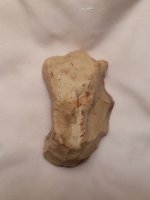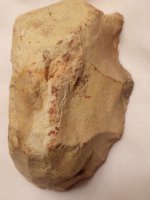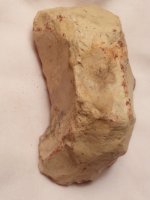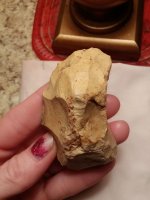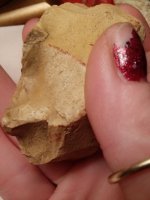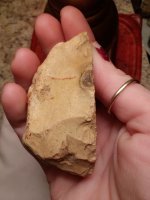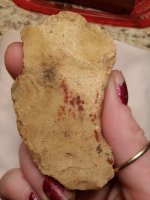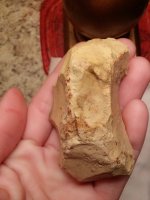Navigation
Install the app
How to install the app on iOS
Follow along with the video below to see how to install our site as a web app on your home screen.
Note: This feature may not be available in some browsers.
More options
You are using an out of date browser. It may not display this or other websites correctly.
You should upgrade or use an alternative browser.
You should upgrade or use an alternative browser.
artifact or artifiction?
- Thread starter mill-Z
- Start date
- Apr 23, 2014
- 3,819
- 4,669
- Primary Interest:
- All Treasure Hunting
What's that mean exactly? What's a biface used for? And it feels and looks a lot like flint
It was something they started but discarded for some reason.
Upvote
0
Georgivs
Bronze Member
- May 16, 2018
- 1,011
- 2,320
- Detector(s) used
- Garret AT pro
- Primary Interest:
- Metal Detecting
I'd say artifact. Also LOL at your title. I've heard these referred to as speed tools, the assumption being that a person knocked a few flakes off of a rock to make a tool that was then discarded after the job was done.
Upvote
0
GoldieLocks
Bronze Member
Did u put a polish on it to make it shiney? I would say from the first photo that it is hand molded clay(edges show air bubbles) and not shale or a native style worked rock.
Upvote
0
Plug N Play
Bronze Member
- Aug 23, 2014
- 1,315
- 3,573
- Detector(s) used
- De Havilland Canada DHC-7-102 Dash 7 - Fugro
- Primary Interest:
- All Treasure Hunting
What's that mean exactly? What's a biface used for? And it feels and looks a lot like flint
Biface simply means it has two faces. Most knapped pieces fall into that category. Think arrowhead ... you can lay it on one face or flip it over and lay it on the other face. Two sided.
Your piece was broken off a larger rock creating a "spall", which is just a large flake. The secondary chipping is almost entirely chipped on only one face. ("upwards", as viewed if layed on the flat face)
Generally, this type of tool is referred to as a Uniface tool ... note the chips only going towards the upper face, leaving the edge as low as possible. Right down at the bottom, if layed on a table.
Google "Limace Artifact" to see other examples of this type of flint knapping.
Often the purpose of this approach is to use the tool more as a scraper rather than a cutter.
Think of sliding your rock across a fish ... doesn't cut the skin but forces the scales upwards and popping off.
Think of scraping a hide ... pops the little pieces of meat upward, leaving the hide clean, but without cuts or holes.
Your tool was meant to lay flat and slide flat while being used. It is an artifact.
edit to add: hump back or turtle back are terms also used for this type of tool, and, yes, I believe yours is flint. (in the states the terms flint and chert both get used ... it's a long twisted conversation about the difference ... lol ... you could use either term and be understood)
Last edited:
Upvote
0
flinthunter
Hero Member
- Jan 3, 2011
- 899
- 1,076
- Detector(s) used
- E-Trac, V3i, DFX
- Primary Interest:
- All Treasure Hunting
In my opinion any flaking done was done by nature. Natural, not altered by man.
Upvote
0
Florida Finder
Bronze Member
Indeed. It’s is a chert artifact. It’s a nearly worn down unifaced scraper.
Upvote
0
Top Member Reactions
-
 3480
3480 -
 1986
1986 -
 1912
1912 -
 1160
1160 -
 1090
1090 -
 1010
1010 -
 889
889 -
 864
864 -
 860
860 -
 795
795 -
 759
759 -
 676
676 -
 659
659 -
 567
567 -
 508
508 -
 453
453 -
 447
447 -
 410
410 -
 401
401 -
E
398
Users who are viewing this thread
Total: 2 (members: 0, guests: 2)
